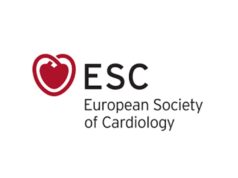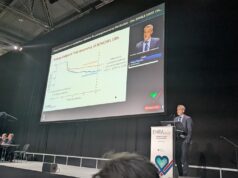
By Angela Gonzalez
The concept of a totally self-contained intracardiac pacemaker, first explored over 40 years ago by J W Spickler et al, has finally become a reality with the implantations of the Nanostim leadless pacemaker (St Jude Medical) and the Micra transcatheter pacing system (Medtronic) in humans. Cardiac Rhythm News speaks to physicians who are currently implanting these devices and industry representatives about the features of this new exciting technology in cardiac pacing.
Chronic performance of the Nanostim, after one-year follow-up of the LEADLESS trial, has shown that the device continues functioning “as expected” with pacing threshold of 0.43 volts and 10.32mV sensing, which are “comparable to traditional pacemakers”, according to data presented by Vivek Reddy (Mount Sinai School of Medicine, New York, USA) at a Late-breaking trial session at the 35th Heart Rhythm Society (HRS) Annual Scientific Sessions (7–10 May, San Francisco, USA). Reddy also said that no safety events were reported at 12 months: “There was no device migration or no device dislodgments, no infections, no mechanical failures or early battery depletion and no pro-arrhythmia,” he noted.
At HRS Scientific Sessions 2013, Reddy presented data—recently published online in Circulation—which demonstrated the safety and feasibility of Nanostim and supported its CE mark approval in October 2013. Last year, the results showed a 97% implant success rate (32 out of 33 patients enrolled), a median procedure duration of 28 minutes and an average hospital discharge of less than two days. In terms of adverse events, one minor groin haematoma, which required no treatment, and one cardiac perforation and tamponade which led to stroke and death were reported—the overall complication-free rate was 94%.
The device, commercially available in Europe, following its CE mark approval, is also being evaluated in an investigational device exemption study for FDA approval (LEADLESS II pivotal trial) and in a European post-marketing approval study (LEADLESS Pacemaker Observational study).
The Micra system is an investigational device and is being assessed in a global pivotal clinical trial. The first successful in-human Micra implantation occurred in December 2013 in Linz, Austria.
Rationale for development of leadless pacing technology
Issues regarding pocket infection or haematomas caused by traditional pacemakers, risks associated with lead failure and the need for improvement in patients’ quality of life have driven the development of this new technology. Werner Jung (head of the Department of Cardiology, Schwarzwald-Baar Klinikum Villingen-Schwenningen, Germany) says that according to published data the in-hospital mortality rate for a traditional pacemaker infection is 8.4% and the 15-month post-implant mortality rate for pacemaker patients with infection is 36.3%, more than double the 15.4% mortality rate of uninfected pacemaker patients. Regarding hospital length of stay for a pacemaker patient with an infection, he says that the average is 14.4 days compared to 4.8 days for pacemaker patients without infections. Agreeing with the common view that the lead is the “weakest link” in traditional pacing technology, Jung says that most common lead problems relate to chronic lead failure such as lead dislodgement or lead fracture, insulation defects, infections that require difficult lead extraction techniques, and to the incompatibility of some leads with magnetic resonance imaging.
Why is leadless pacing possible now?
Drew Hoffman (senior vice president and general manager of Nanostim at St Jude Medical) says that 40 years ago “the technology was not available to allow for miniaturisation sufficient to place a pacemaker directly into the heart without the loss of important functionality, such as battery life.” The battery of the Nanostim, he notes, “despite the miniaturisation [Nanostim is less than 10% the size of a traditional pacemaker] is expected to have an average lifespan of more than nine years at 100% pacing, or more than 13 years at 50% pacing.”
In the case of Medtronic, Mike Hess (vice president of Research and Development for the Bradycardia business at Medtronic) comments, the Micra project took seven years to become a reality. He says: “A lot of the time was spent on designing how the Micra device attaches to the heart and how to deliver it into the heart. At the same time, we were working on new, more efficient circuits and designing a battery that was small enough to power the device for about 10 years.” Regarding dimensions, the Micra device is “the smallest pacemaker in the world being 30% smaller than Nanostim,” he says. This miniaturisation is part of a broader initiative at Medtronic called “deep miniaturisation” which has developed other devices such as the recently launched Reveal Linq, which is the smallest insertable cardiac monitor available for patients, Hess notes.
More similarities, differences and limitations
Both the Nanostim and Micra devices are single-chamber pacemakers placed directly into the heart with a steerable catheter through the femoral vein. It is a procedure that, according to Larry Chinitz (director of the Heart Rhythm Centre at New York University (NYU) Langone Medical Centre, New York City, USA), is very familiar among electrophysiologists. “It is a relatively straightforward, easy-to-learn procedure, very adaptable to our usual techniques,” he says.
Chinitz, who implanted the first Micra device in the USA in February 2014, and Jung, who has implanted the Nanostim device in seven patients as part of the LEADLESS Observational European post-approval trial, both comment that procedure times with the Micra and Nanostim devices are shorter—lasting from 30 to 45 minutes—than those with traditional pacemakers (about one hour). Vivek Reddy noted at HRS 2014 that the experience implanting Nanostim in the two major studies for the device (LEADLESS II and LEADLESS Observational study) has shown an “overall trend in decreasing procedure time, so ultimately some of the procedures could last for 20 minutes”.
Retrieval of the Nanostim device at the time of implantation and later is possible. Drew Hoffman, from St Jude Medical says, “The Nanostim device is designed to be fully retrievable so that it can be readily repositioned during the implantation and later retrieved if necessary.” The results of the LEADLESS trial revealed two cases that needed device retrieval, one due to inadvertent placement in the left ventricle and another due to revealed ventricular tachycardia two days after implantation. Reddy et al reported successful retrieval and implantation of a new device placed in the right ventricle in the first case and successful Nanostim removal in the second patient, who was thereafter implanted with an implantable cardioverter defibrillator.
The Micra device has also been designed to be retrieved at the time of implantation if needed, Mike Hess, from Medtronic, comments, “there is a way that allows physicians to snare the device and pull it back into the delivery system, and then it will extract the tines or remove the tines from the heart and let them position the device somewhere else.” The Micra device is in its early stages of clinical investigation and, so far, no retrieval cases with the Micra device have been reported yet, he notes.
After Reddy’s one-year follow-up of the LEADLESS trial presentation at HRS 2014, strategies for device replacement and retrieval in the long run were addressed. Reddy mentioned that there is preclinical data showing that the Nanostim device can be retrieved at approximately six months after implantation in animal models. Regarding possibilities in the long term, he said: “Will the device endothelialise so thoroughly that the retrieval catheter would not be able to grab back? The real answer is: we will know 10 years from now when we start removing these devices. Having said that, there are plans in a few animal that have been implanted [in some studies] to allow for a chronic assessment of device retrieval and we should know later this year the feasibility of these removals.” Reddy also said that “it is not impractical to think about putting one or two or three of these devices, ultimately, in the patient.”
Among the differences between the two devices, Werner Jung highlights the introducer sheath and the fixation approach. He says that the Nanostim uses a smaller sheath in diameter (18F) than what it is required for the Micra device (23F). “This is an important difference in that it may impact access to stop bleeding after the procedure,” he notes. Chinitz also comments that Micra’s larger sheath “may lead to some transient vascular problems, but in our experience [four implantations reported on 14 April 2014] we have not seen any issues yet.”
The fixation approach used with the Nanostim device is “very similar to what is used today with conventional pacemaker leads,” explains Jung. “The device is fixed to the heart via a helix. This is key because it is part of the overall system that enables the device to be potentially retrievable over its entire lifetime.”
The Micra device includes active fixation tines (tines that actively attach into the tissue) that keep the device in place in the heart. However, “this fixation technique might be a potential problem for chronic retrievability,” Jung speculates. In contrast, Hess says that the fixation approach of Micra “is quite appropriate for this technology. We chose not to use the fixation that pacing leads use because this was a very different kind of device. We do not think that the pacing lead helix approach necessarily makes sense if you do not have a pacing lead attached to the device.”
Medtronic also believes the size of Micra gives it an advantage over Nanostim. Hess comments: “Our design goal was to have more flexibility in where you place the device, and so by having it much shorter it can be placed in more locations in the apex or the septum, if necessary, in the ventricle.”
The most relevant limitation, according to both the industry representatives and the physicians Cardiac Rhythm News spoke to, is that the current Nanostim and Micra devices are indicated for patients requiring a single-chamber pacemaker only, limiting their use to a “relatively small part of the overall pacemaker market,” says Hess. Jung comments that in Europe, the indication for a single-chamber or dual-chamber pacemaker varies between 22% to 32% and 64% to 75%, respectively. Current indications for Nanostim, as Jung reports, are for patients with chronic atrial fibrillation and second or third atrioventricular degree block, patients with sinus rhythm with second or third atrioventricular block and a low level of physical activity or short expected lifespan and patients with sinus bradycardia with infrequent pauses or unexplained syncope. Larry Chinitz says that the Micra device is indicated for patients with bradycardia, patients with syncope or patients with sick sinus syndrome.
Drew Hoffman comments that St Jude Medical is now researching options for dual-chamber leadless pacing technologies. “We have received feedback that as time goes on, and the technology is proven, implanters will use leadless technology exclusively.”
While initial official results with the Micra global pivotal trial, according to Medtronic, are expected in the second half of 2014, Chinitz comments that so far the reaction from patients receiving this technology has been “extremely positive”. With no complications reported from Chinitz personal experience with Micra to date, he says that leadless technology “is a very disruptive technology, it changes the way we think about implantable devices, and the future development of devices. I think it will be revolutionary in the field of pacing and eventually defibrillation.”
Jung, who has not reported complications with his Nanostim implantations, considers that leadless pacing is a “revolutionary breakthrough” that could potentially impact not only the quality of life of patients but also provide a reduction of costs compared to traditional pacing management systems.












